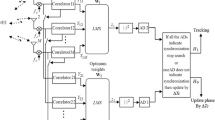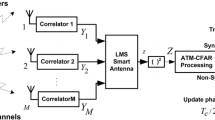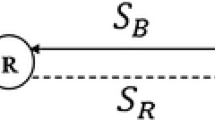Abstract
Traditional analysis on PN code acquisition was based on either AWGN or single-ray Rician/Rayleigh fading channels. In this paper, we analyze single-dwell and multidwell code acquisition schemes based on a two-ray Rayleigh fading channel model which is more appropriate to represent the real situations in mobile (personal) communication. Through the analytical and numerical results, we may figure out the performance of typical PN code acquisition schemes and the corresponding penalty in multipath fading channels when the second ray has much smaller power and the processing gain is not large. Otherwise, the second ray may be useful in communication and thus improves the acquisition performance as introducing a new correct acquisition state.
Similar content being viewed by others
References
J. K. Holmes and C. C. Chen, Acquisition time performance of PN spread-spectrum system,IEEE Transactions on Communications, Vol. COM-25, pp. 778–783, 1977.
D. M. DiCarlo and C. L. Weber, Statistical performance of single dwell serial synchronization system,”IEEE Transactions on Communications, Vol. COM-28, No. 8, pp. 1382–1388, 1980.
V. M. Jovanvić, Analysis of strategies for serial search spread-spectrum code acquisition-direct approach,IEEE Transactions on Communications, Vol. 36, pp. 1208–1220, 1988.
V. M. Jovanvić, On the distribution function of the spread-spectrum code acquisition time,IEEE Journal on Selected Areas in Communications, Vol. 10, No. 4, pp. 760–769, 1992.
M. K. Simon, J. K. Omura, R. A. Scholtz, and B. K. Levitt,Spread Spectrum Communication III, Computer Science, Rockville, MD, 1985.
D. M. DiCarlo and C. L. Weber, Multiple dwell serial search: Performance and application to direct sequence code acquisition,IEEE Transactions on Communications, Vol. COM-31, No. 5, pp. 650–659, 1983.
D. E. Dodds, S. M. Pan, and A. G. Wacker, Statistical distribution of PCM framing times,IEEE Transactions on Communications, Vol. 36, No. 11, pp. 1236–1241, 1988.
S. M. Pan, D. E. Dodds, and S. Kumar, Acquisition time distribution for spread-spectrum receiver,IEEE Journal Selected Areas Communications, Vol. 8, No. 5, pp. 800–808, 1990.
Y. H. Lee and S. Tantaratana, Sequential acquisition of PN sequences for DS/SS communications: Design and performance,IEEE Journal on Selected Areas in Communications, Vol. 10, No. 4, pp. 750–759, May 1992.
G. M. Comparetto, A generalized analysis for a dual threshold sequential detection PN acquisition receiver,IEEE Transactions on Communications, Vol. 35, No. 9, pp. 956–960, 1987.
Y. T. Su and C. L. Weber, A class of sequential tests and its applications,IEEE Transactions on Communications, Vol. 38, No. 2, pp. 165–171, 1990.
W. B. Kendall, Performance of the biased square-law sequential detector in the absence of signal,IEEE Transactions on Information Theory, pp. 83–90, 1965.
G. E. Albert, On the computation of the sampling characteristics of a general class of sequential decision problems,Annals of Mathematical Statistics, Vol. 25, pp. 340–356, 1954.
L. D. Davisson and P. G. Flikkema, Fast single-element PN acquisition for the TDRSS MA system,IEEE Transactions on Communications, Vol. 36, No. 11, pp. 1226–1235, 1988.
P. G. Flikkema and L. D. Davisson, Performance analysis of a spread spectrum acquisition algorithm for satellite mobile radio,IEEE Milcom, 1992.
N. D. Willson, S. S. Rappaport, and M. M. Vasudevan, Rapid acquisition scheme for spread-spectrum radio in a fading environment,IEE Proceedings, Vol. 135, Part F, No. 1, 1988.
J. W. Mark and I. F. Blake, Rapid acquisition techniques in CDMA spread-spectrum systems,IEE Proceedings, Vol. 131, Part F, No. 2, pp. 223–232, 1984.
E. A. Sourour and S. C. Gupta, Direct-sequence spread-spectrum parallel acquisition in a fading mobile channel,IEEE Transactions on Communications, Vol. 38, No. 7, pp. 992–998, 1990.
E. A. Sourour and S. C. Gupta, Direct-sequence spread-spectrum parallel acquisition in nonselective and frequency-selective Rician fading channels,IEEE Transactions on Communications, Vol. 10, No. 3, pp. 535–544, 1992.
D. M. Dlugos and R. A. Scholtz, Acquisition of spread spectrum signals by an adaptive array,IEEE Transactions on Acoustics, Speech, and Signal Processing, Vol. 37, No. 8, pp. 1253–1270, 1989.
A. Weinberg, Generalized analysis for the evaluation of search strategy effects on PN acquisition performance,IEEE Transactions on Communications, Vol. COM-31, pp. 37–49, 1983.
W. R. Braun, Performance analysis for the expanding search PN acquisition algorithm,IEEE Transactions on Communications, Vol. 30, No. 3, pp. 424–435, 1982.
G. S. Glišić, Automatic decision threshold level control (ADTLC) in direct-sequence spread-spectrum systems based on matching filtering,IEEE Transactions on Communications, Vol. 36, No. 4, pp. 519–527, 1988.
G. S. Glišić, Automatic decision threshold level control in direct-sequence spread-spectrum systems,IEEE Transactions on Communications, Vol. 39, No. 2, pp. 187–192, 1991.
C. C. Huang, Delay spread and channel dynamics measurements at ISM Bands,Proc. ICC'92, 1992.
R. Ganesh and K. Pahlavan, On the modeling of fading multipath indoor radio channels,IEEE Globecom, Dallas, Texas, 1989.
Adel A. M. Saleh and Reinaldo A. Valenzuelo, A statistical model for indoor multipath propagation,IEEE Journal Selected Areas Communications, Vol. SAC-5, pp. 128–137, 1987.
A. Polydoros, C. L. Weber, A unified approach to serial search spread-spectrum code acquisition. Part 1,IEEE Transactions on Communications, Vol. COM-32, No. 5, pp. 542–560, 1984.
J. K. Holmes,Coherent Spread Spectrum Systems, Wiley, New York, 1982.
G. S. Glišić, Power density spectrum of the product of two-displaced version of a maximum length binary pseudonoise signal,IEEE Transactions on Communications, Vol. 31, No. 2, pp. 281–286, 1983.
I. Korn, Differential phase shift keying in two-path Rayleigh channel with adjacent channel interference,IEEE Transactions Vehicular Technology, Vol. 40, No. 2, pp. 461–471, 1991.
Author information
Authors and Affiliations
Rights and permissions
About this article
Cite this article
Cheng, TY., Chen, KC. Single-dwell and multidwell PN code acquisition in multipath Rayleigh fading channels. Int J Wireless Inf Networks 2, 165–182 (1995). https://doi.org/10.1007/BF01577280
Issue Date:
DOI: https://doi.org/10.1007/BF01577280




